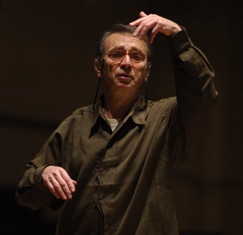Part III. Technique.

Technique is
a word that conjures method, mechanics and surgically sharpened vocabulary.
In the case
of orchestral conducting, it is much more personal, said Leonid Grin,
co-instructor with Neeme Järvi at the 2010 Neeme Järvi International Summer
Academy in Pärnu, Estonia.
“Our
technique is our language. Our technique
is our personality. Your professors can
give you general patterns, how to do this or that, but it is just a
beginning. From these patterns, you have
to develop your own individual technique, because you have your own individual
language. You say, ‘my technique’ and we
speak about manual technique, but that is the smallest part of a conductor’s
technique, 25 percent at the most.”
A conductor’s
technique comprises all of one’s body, said Russian born Grin, a protege of Leonard Bernstein and former music director of the San Jose Symphony. “Verbal ability, gestures, mimics, face, expression, eyes, posture. If you go on the podium and you conduct like
a 75-year-old person with arthritis, but you’re just 25 years old . . . You can’t
stand like this. Your posture presents
your assurance, your image."
A conductor
does not play an instrument like the rest of the orchestra, Grin stressed. “Where is the sound that you
produce? It’s your own body. Everything from your head to the very lowest
part of your body. Like a singer, it’s
all your resonator. That is where our
sound forms. That’s why every conductor
has his or her individual sound.
That’s why when we hear (Carlo Maria) Giulini conduct the Los Angeles Philharmonic, it
has one sound, when (Gustavo) Dudamel conducts the Los Angeles Philharmonia it has a
different sound, and when Zubin Mehta conducts the Los Angeles Philharmonic, it
has a third sound.”
Posture is
very important, said Grin, who now teaches privately in Philadelphia. “If you bend
your neck, you cut off the upper resonator.
Your will lose a lot of timbre. When
you bend, you weaken the intensity so you will have no сила (Russian for “force”).” Conducting should begin mid-level and build
from there, he said.
Force, he said implies ego, a trait which conductors are
assumed to possess in over-abundance. Here, Grin quoted William Steinberg (1899-1978), conductor
of the Pittsburgh Symphony: “A conductor
is one who is capable of making the work speak for itself. One who, besides integrity, has intuition and
inspiration and who can have enough modesty to hide himself from the eyes of a
crowd craving for entertainment, or to be provoked.”
“In other words,” said Grin, “hide your ego. ‘My Bach, my Beethoven, my Mozart.’ It’s not mine. Mozart belongs to Mozart, Beethoven belongs
to Beethoven. Our task as a conductor
is to do the best we can to move into the world of the composer we are
studying. In my life, hundreds of people
have asked me ‘Who is your favorite composer?’
I have just one answer to this: ‘The one I am conducting tonight.’ If I don’t feel this way, I should not
conduct tonight. I will not do a good
job for the composer.”
Grin said that in addition to reading and dissecting a score
he tries to get whatever information he can about the composer and the
circumstances under which the work was written.
“These days we have so much information about the inner world of
Schumann, for instance, his illusions, his sexual issues, his psychology. When I conduct Wagner’s ‘Siegfried Idyll,’ I
have to read the score over and over and the letter he wrote to his wife over
and over because Wagner’s spirit is there.”
Returning to a work one has conducted many times previously is
another issue. “That was
another piece," said Grin, associate conductor of the Moscow Philharmonic before immigrating to the U.S. in 1981. "If I know in three weeks
I have to do Brahms’ Second Symphony for the 26th time in my life, I
will spend two weeks from the very beginning, as I did before. I listen to my performances in different
periods of my life. I do not repeat
myself. Something every time is
different. It’s new. Whatever you do, do it as you do it the
first time.”
See parts I and II in “Features” on this site.
(to be continued)